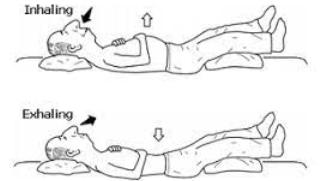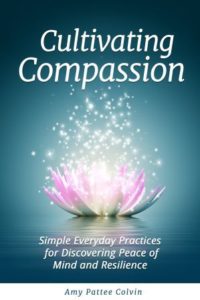How breathing works
Breathing is a natural part of life.
When we’re not consciously controlling it, the autonomic nervous system controls our breath. This system works automatically, without conscious effort.
Unlike other visceral (e.g., digestion, endocrine, cardiovascular) functions, breathing is unique because it can be regulated voluntarily. Automatic breathing requires no attention to maintain, whereas voluntary breathing involves a given amount of focus.
If you try to hold your breath, your body will override your action and force you to exhale and start breathing again. The respiratory centers that control your rate of breathing are in the brain-stem or medulla. The nerve cells that live within these centers automatically send signals to the diaphragm and intercostal muscles to contract and relax at regular intervals.
Chest breathing
Typically, when we pay no attention to our breath, it will do its essential job of oxygenating our systems and keep us alive. But, we can choose to gain benefits from breathing beyond merely staying alive. The first time this idea entered my awareness was many years ago when a shiatsu instructor told me I breathed enough to stay alive, but not enough to be of more significant benefit to my body.
- I took small shallow breaths into the top lobes of my lungs, using the chest muscles to inflate the lungs by pulling on the rib cage.
- My chest expanded and contracted with each breath, and my abdomen was not involved.
- These breaths were short and quick, using only a small part of the lungs and delivering a relatively minimal amount of oxygen to the bloodstream.
Belly breathing
A few years later my meditation instructor told me to “breathe, breathe!” For some reason, I thought he was speaking metaphorically, and I finally asked him if he really meant, you know, breathe, like inhale, exhale. He looked at me, cocked his head, and said, “Yes! Inhale, exhale, from your belly.”
- The term refers to breaths that use your entire lung capacity.
- The diaphragm and abdominal muscles pull down on the abdominal cavity to fully inflate the lungs.
- The chest expands very little if at all while stomach breathing, while the abdominal area expands noticeably.
- Breaths that are taken while stomach breathing are slow and deep, taking longer to inhale and exhale and delivering a more significant amount of oxygen to the bloodstream.
Which kind of breather are you?
Lie on your back with your hands on your abdomen to see whether you typically are a chest or stomach breather.
If you feel your hands rise and fall, you’re a stomach breather, but if your hands remain mostly stationary, you’re a chest breather.
Practice belly breathing with these three easy steps:
1) Lie on your back on a flat surface or in bed. Use a pillow under your knees to support your legs if needed. Place one hand on your upper chest and the other just below your rib cage. This hand placement will allow you to feel your diaphragm move as you breathe.
2) Breathe in slowly through your nose so that your stomach moves out against your hand. The hand on your chest should remain as still as possible.
3) Breathe out slowly through your nose or mouth. Tighten your stomach muscles, letting them fall inward as you exhale. The hand on your belly moves toward the floor, and the hand on the upper chest remains as still as possible.
Hint: You may notice an increased effort is needed to use the diaphragm correctly. At first, you may get tired while doing this exercise. If you want to strengthen your diaphragm and abdominal muscles involved put a book or a light weight on your belly and practice deep breathing for three to five minutes. Make a conscious effort to breathe from the diaphragm whenever you notice that you’re breathing from your chest. As your body becomes accustomed to stomach breathing, you’ll naturally take deeper belly breaths with less conscious prompting. Belly breathing is also a wonderfully relaxing way to ease into sleep.
How to breathe while meditating
Now that we’ve covered the basics of how to breathe deeply, let’s explore how deep breathing enhances your health and meditation practice. You can breathe into and out from either your nose or mouth, whichever is more comfortable for you at the moment.
However, during each meditation, choose one method and stick with it. As you breathe, consider these four concepts: slowly, deeply, smoothly, long. When you combine all for elements notice how quickly your body begins to relax. Practicing all four at the same time reduces the stress hormone cortisol, and oxygenates your brain.
Close your eyes, or soften your gaze. A softened gaze relaxes the mind, disengaging it from the energy of the external environment.
Belly breathing creates an anchor for our mind (to keep it from drifting) as we pay attention to the rise and fall of our abdomen.
We choose to focus our attention on the inhale and exhale and not on the shopping list or the next chore. This focused attention, or freedom from distraction, is a foundation for meditation practice.
As you are learning, it is helpful to experiment with the following tips while breathing deeply:
1) Silently say for yourself, “inhale, exhale” with each cycle of breath.
2) Count your breaths. Some suggest counting to ten or five, but Dr. Herbert Benson found that people experienced a stress response when counting to ten, as their minds often drifted off. Dr. Benson suggests counting to one, then counting to one on the next breath.
3) Practice a fully flowing breath. This technique
This conscious connection with breath enhances our qi (internal energy) and can decrease physical and emotional stress and increase a sense of calm and relaxation. Breathing deeply with intention and attention also connects us to our intuition and the divine within.
Four-Part Breathing Meditation
The four-part breathing meditation is a helpful technique not only during your daily meditation practice but also during times of stress. It allows you to create a moment of calm in a chaotic situation which may, in turn, enable you to respond rather than react. It can be practiced anywhere at any time—in the grocery line, before a meeting, or as part of
Find a comfortable posture. Close your eyes or drop your gaze. Take a moment to focus on relaxing the muscles throughout your body (including your tongue).
- Breathe into your belly for a count of four.
- Pause your breath for a count of four.
- Exhale for a count of four.
- Pause again for a count of four.
Repeat as often as you wish. Do not worry about whether you have achieved a deep level of meditation. Simply enjoy the fact that you chose to take this time for yourself, your mind, your body, and your spirit.
As your meditation practice deepens, let your breath wander on its own without paying any intentional attention to it. But remember, it is a wonderful anchor if you find yourself distracted.
If you’d like to learn more about this concept, or any of the techniques mentioned in this post, explore these options.
Explore focusing your mind and increasing your inspiration through the Aspire: Goals Visualization app filled with a selection of mind-focusing visualizations.
Attend an International Spiritual Tour ~ These tours uniquely blend exploration of beautiful landscapes and cultures with meditation, qigong, and rich conversations about acceptance, compassion, and joy.









